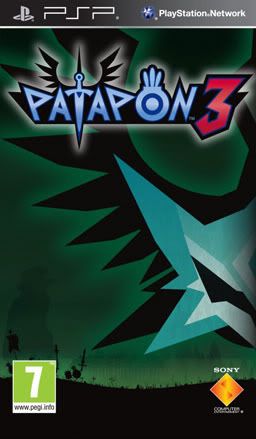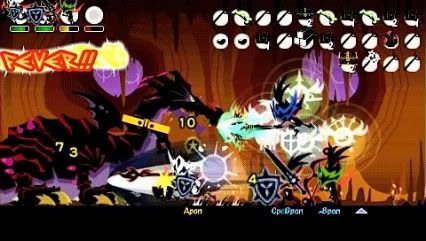
- Format: PSP
- Unleashed: Out Now
- Publisher: Sony Computer Entertainment
- Developer: Pyramid, Japan Studio
- Players: 1-8 (1-4 Co-oP, 4 Vs 4)
- Site: http://www.patapon-game.com/
The Patapon franchise has quietly been passing its time on the PSP since 2008, mixing RPG elements with real time rhythm-keeping battles against wildlife, enemy tribes and huge Archfiend monsters. Patapon 3 tells the tale of the latest adventure of the humble Patapon tribe, picking up shortly after where Patapon 2 left off.
If you are entirely new to the franchise it may be a little daunting when you first see the adorable little eyeball-centric Patapons taking to a silhouetted battlefield, singing and dancing as they fight. The ‘rhythm of the earth’ essentially keeps the beat around the border of the screen and using this you can time the commands you give your Patapon army to attack, defend, charge, jump or retreat; with bonuses being conferred the better you are at keeping the correct four-beat rhythm. Throw into this RPG elements outside of battle as you collect equipment, level up characters, complete quests and manage items – and you have a game which is far more complicated than its appearance may suggest.
 Unlike the previous two titles which saw you playing the role of the Patapon God, this time around you are given a choice of which of three Superhero Patapon you wish to play (each focusing on either attack, defence or support). This hero is saved from the mass-petrification curse that befell the tribe after accidentally freeing the evil Archfiends at the end of the previous game. Though this might sound fairly heavy, the story is for the most part portrayed in a cute cartoon like style with the Patapons often quipping jokes, silly comments or making self-aware references to what’s going on.
Unlike the previous two titles which saw you playing the role of the Patapon God, this time around you are given a choice of which of three Superhero Patapon you wish to play (each focusing on either attack, defence or support). This hero is saved from the mass-petrification curse that befell the tribe after accidentally freeing the evil Archfiends at the end of the previous game. Though this might sound fairly heavy, the story is for the most part portrayed in a cute cartoon like style with the Patapons often quipping jokes, silly comments or making self-aware references to what’s going on.
It isn’t just the hero you select that has a choice of classes and it, along with each of your Patapon units, will unlock around six other classes to change into. Gone is the generic army management previously used, with the focus now being on your hero and three other units which are far more customisable overall. This also means a lot more management of statistics and equipment, but a general ‘optimise’ option is there for those more interested in the questing side of things.
Like the previous two games the story plays out across numerous locations around your base of operations with side-quests and generic repeatable areas unlocking as you go. The Patapon games are notoriously quite challenging and this is the hardest of the lot, so even more grinding is required beyond the already high amounts previously needed. Often, areas rated at the level your Patapons are at will prove too difficult until either you level once or twice more above the recommendation, or pump money into upgrading equipment.
 What doesn’t help is that along with a vast amount of patience being required on your part, an equal or greater amount of concentration is also demanded. Keeping perfect rhythm is not an optional advantage – it’s necessary. Without filling your ‘fever’ bar with exact commands you will often be utterly destroyed and will not gain access to powerful summon attacks. The slightest mistake (particularly with the summon command which is a five-beat input within a four-beat rhythm) will result in fever being lost and all bonuses instantly disappearing – not to mention starting from scratch towards trying to fill it again. The bottom line is that if you suspect there is any reason you won’t be able to focus for five to fifteen minutes for a quest without being interrupted, you should not start playing.
What doesn’t help is that along with a vast amount of patience being required on your part, an equal or greater amount of concentration is also demanded. Keeping perfect rhythm is not an optional advantage – it’s necessary. Without filling your ‘fever’ bar with exact commands you will often be utterly destroyed and will not gain access to powerful summon attacks. The slightest mistake (particularly with the summon command which is a five-beat input within a four-beat rhythm) will result in fever being lost and all bonuses instantly disappearing – not to mention starting from scratch towards trying to fill it again. The bottom line is that if you suspect there is any reason you won’t be able to focus for five to fifteen minutes for a quest without being interrupted, you should not start playing.
Perhaps at this point you are thinking that you could just pause the game. Once or twice while playing we were interrupted and wished we could do the same – especially during multi-floor dungeons which require starting over from scratch if ended prematurely. Patapon games have previously been criticised for not including the ability to pause and at first we thought this was just the same. Imagine our surprise when we learned that somewhere in the training ground you could learn a new command which would pause the game.
This was strange as we had already completed that area; but it turns out that only by pushing through to the very end of the first training mission could you earn the pause command. Despite coping well enough with keeping rhythm and progressing through the plot at a fair pace, after two hours of attempting this we were forced to give up earning the right to pause the game.
Assuming you can put up with frustration and copious grinding (and you enjoy rhythm games) then the singleplayer experience will offer something to you. The focus of Patapon 3′s development has been on multiplayer aspects however. Either online or locally you can make a team of friends to tackle missions together (including bonus quests against huge powerful beasts).
Due to ongoing PSN problems we were not able to test the online functions at time of writing. Local play is flawed slightly though unless you have a large circle of friends who all purchased the game; because if you only go into quests with one person’s superhero you will be at a huge disadvantage.
Patapon 3 is an interesting game. If you can put up with the problems mentioned above there is some fun to be had here that could appeal to a wide range of ages. It is not a game you could play on the go or with distractions around you, nor is it a game that could be played for any great length of time – unless you find hearing PATA-PATA-PATA-PON in your head even when not playing acceptable.
















Comments